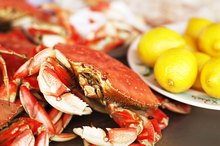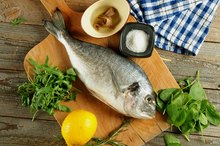What does fact checked mean?
At Healthfully, we strive to deliver objective content that is accurate and up-to-date. Our team periodically reviews articles in order to ensure content quality. The sources cited below consist of evidence from peer-reviewed journals, prominent medical organizations, academic associations, and government data.
The information contained on this site is for informational purposes only, and should not be used as a substitute for the advice of a professional health care provider. Please check with the appropriate physician regarding health questions and concerns. Although we strive to deliver accurate and up-to-date information, no guarantee to that effect is made.
Cholesterol & Seafood
It is important to keep your cholesterol at a healthy level. Eating foods with too much saturated fat can raise blood cholesterol and have adverse effects onf the health of the body. Seafood naturally contains cholesterol, but the amounts and effects may not be as scary as people think. You can enjoy all types of seafood in your diet and still maintain good cholesterol levels.
Effects
Some types of seafood have positive effects on cholesterol. Fatty fish, such as salmon or mackerel, increases HDL levels in the blood. HDL is known as “good” cholesterol because high levels help lower your risk of coronary artery disease. Other fish, such as sardines and tuna, contain beneficial omega-3 fatty acids and lower triglyceride levels in the blood as well. According to the American Heart Association (AHA), including seafood in your diet may help to prevent cardiovascular disease 2.
- Some types of seafood have positive effects on cholesterol.
- Other fish, such as sardines and tuna, contain beneficial omega-3 fatty acids and lower triglyceride levels in the blood as well.
Misconceptions
Cholesterol Levels in Shellfish
Learn More
Shellfish is often avoided by many because of the misconception that it raises bad cholesterol levels. According to a study at the University of Washington, shellfish pose no danger to cholesterol levels. This study found that some of the most commonly eaten shellfish, including oysters, crabs, clams, shrimp and mussels, showed no evidence of raising cholesterol levels. Crab and clams actually lowered the LDL levels (bad cholesterol). Mussels and oysters also lowered LDL, while raising HDLs. Fish and seafood contain a small amount of cholesterol, but are also rich in healthy, unsaturated fat and low in saturated fat, the type of fat that tends to raise blood cholesterol..
- Shellfish is often avoided by many because of the misconception that it raises bad cholesterol levels.
- According to a study at the University of Washington, shellfish pose no danger to cholesterol levels.
Size
Seafood is a part of a healthy balanced diet 1. The AHA recommends that no more than 300 mg of cholesterol per day is healthy for adults. Most of the commonly eaten seafood selections are well below this parameter. For example, 3 oz. of lobster contains 61 mg of cholesterol; 3 oz. of crab contains 80 mg of cholesterol. There are 166 mg in a serving of 15 shrimp, and 48 mg in a serving of five mussels. Six oysters contain 58 mg of cholesterol, and a serving of four scallops has less than 34 mg.
- Seafood is a part of a healthy balanced diet 1.
- Six oysters contain 58 mg of cholesterol, and a serving of four scallops has less than 34 mg.
Considerations and Warnings
Is Crab Meat High in Cholesterol?
Learn More
You can increase the amount of cholesterol in your seafood by how you choose to prepare it. Deep frying, and using butter and sauces will increase the cholesterol content of seafood or any other food. Try broiling, grilling or baking when preparing seafood and cook with very little oil.
The key to maintaining healthy cholesterol levels in any food is moderation. If you eat an excessive amount of seafood containing cholesterol, your cholesterol intake from other foods should be modified so that you don’t exceed the recommended 300 mg per day.
- You can increase the amount of cholesterol in your seafood by how you choose to prepare it.
Title
No text
This is an Extra Section
no text
This is an Extra Section
No text
Related Articles
References
- Seafood Health Facts: Seafood and Nutrition
- American Heart Association
- Dipiro JT, Talbert RL. Pharmacotherapy: A Pathophysiological Approach, 9th ed 2014.
Writer Bio
A resident of Atlanta, Niya McIver has recently channeled her nutrition experience into a writing career. For the past year, her articles have appeared in Examiner.com, where she's a consistent nutrition contributor. She studied psychology at Florida State University.









